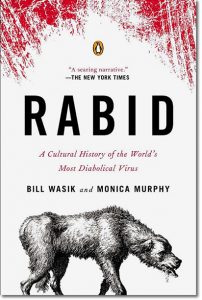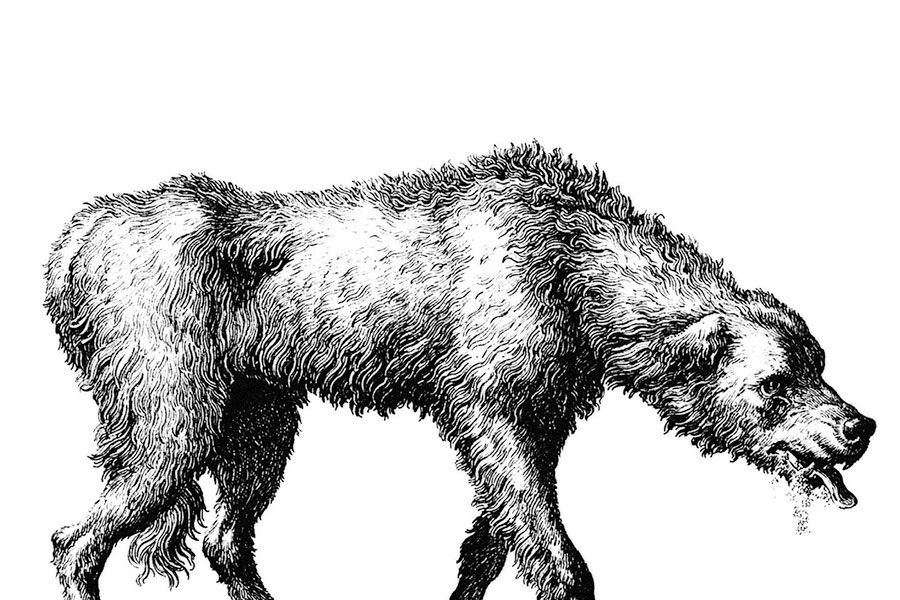By Bill Wasik and Monica Murphy
The full subtitle of this book neatly encapsulates its theme and tone: A Cultural History of the World’s Most Diabolical Virus. Note that it identifies itself not as a general or scientific history, but as a “cultural” one. This is an accurate descriptive; for truly, few diseases known to humanity have branded themselves into our collective psyche and culture so widely, so deeply, and for so long; and as something not merely organically deadly but infernally so, and thus profoundly to be feared. (The few others that even come close include leprosy and polio.)
Though shelved in the non-fiction area of your library or bookstore, Rabid spins a series of tales and observations that could have come from the fictional horror story pen of Stephen King. It is at once fascinating and terrifying. The authors, a husband-and-wife team, are eminently qualified to write such a book. Wasik is a magazine editor who writes about science and technology; while Murphy is a veterinarian with a degree in public health. Together they have put together the definitive “biography” of the rabies pathogen.

Paperback: 288 pages
Publisher: Penguin Books, 2012
ISBN: 978-0143123576
Available at Amazon and other book vendors
As skilled and informed storytellers, they waste no time in drawing the reader into their chilling narrative. By way of introduction to their subject, on page 2 they recount an incident that occurred right here in Ketchum’s own neck of the woods in order to describe how seemingly “meek woodland creatures” can be transformed by the rabies virus into “bewilderingly avid attackers”:
Sometimes they will even attempt a home invasion, as one young couple in the Adirondack hamlet of Lake George, New York, learned on an April evening just a few years ago. Walking from their car, they were set upon by a gray fox; they managed to rush inside their home and close the door. But nearly a half hour later, when they opened the door again, the fox lay in wait; it sprinted toward the opening. Only quick reflexes allowed the young man to close it just as the devil’s snout broached the threshold. When an animal control officer arrived, the fox attacked his SUV, repeatedly sinking its teeth into the vehicle’s tires. He shot at it multiple times from his driver’s side window but failed to hit his mark. Later, after the officer had finally run the fox over, he told a reporter that it was the single most aggressive foe he had encountered in nine years on the job. ‘This was a four- or five-pound animal attacking a 3,000-pound vehicle,’ he said.
As the usage of words and phrases like “diabolical” and “devil’s snout” suggests, the authors have no intention of boring the reader with some dry, clinical, academic study of rabies—regarded as “the most fatal virus in the world.” Indeed, throughout the book the disease itself almost assumes a personality of its own, best described as pure, conscious malevolence. Even the technical description of how the rabies virus attacks its host reads like a scene out of a gripping horror novel:
On entering a living thing, it eschews the bloodstream, the default route of nearly all viruses but a path heavily guarded by immune-protective sentries. Instead, like almost no other virus known to science, rabies sets its course through the nervous system, creeping upstream at one to two centimeters per day (on average) through the axoplasm, the transmission lines that conduct electrical impulses to and from the brain. Once inside the brain, the virus works slowly, diligently, fatally to warp the mind, suppressing the rational and stimulating the animal.
Through ten exquisitely researched chapters, chock full of facts and anecdotes spanning four thousand years, the authors take us on a compelling ramble encompassing the history, science, and cultural backdrop of rabies. From Greek myths to zombie flicks, from the laboratory heroics of Louis Pasteur to the contemporary search for a lifesaving treatment, Rabid is a fresh and often wildly entertaining look at one of humankind’s oldest and most fearsome foes. Whether your interests tend toward science, medicine, history, art, or just a good yarn well told, you will find this lively and entertaining book hard to put down. We heartily recommend it.
And, of course, if you are a pet owner, it is a stark reminder of the importance of getting your dog or cat vaccinated against rabies and tagged with the most up-to-date rabies tags. (For a limited time, save 10% on your 2020 tags from Ketchum Mfg. Co.!)

2020 Rabies Tags

2020 Rabies Tags

2020 Rabies Tags







